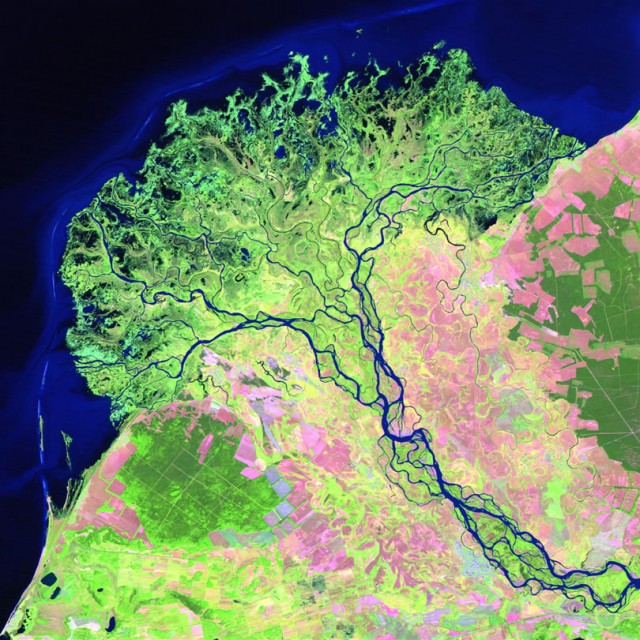delta
A DELTA IS AN AREA of land that has been built up at the mouth of a river, where it flows into a quiet body of water, such as a lake or an ocean. The delta is formed when the river, which is moving swiftly and carrying sediment such as mud, slows down to enter the larger body of water. At the slower speed, the water can't carry as much sediment, so most of it is dropped onto the bottom of the ocean. It builds up layer by layer, over a long period of time, until it is above the surface of the water.
The delta builds up at the end of the river itself, since it cannot rise higher than the surface of the ocean. As more and more sediment is deposited, the delta grows in size and extends further upstream. The more mud the river carries, the faster a delta will build up. Most deltas have a roughly triangular shape. The name came from the Greek letter delta, which is shaped like a triangle. If plants grow on the delta, their roots and remains become part of the soil, enriching it. A delta is an ever-changing landform. If the original channel of the river is filled with sediment, the stream will overflow across the surface of the delta, dividing into smaller streams or channels called distributaries.

The size and shape of the delta depends on several factors. If the waves are strong where the river enters the ocean, any deposits will be washed away and a delta will not form. The weaker the waves in the ocean at that point, the more the delta will build up. Delta formation is also dependent upon the amount of material being carried by the river. If waves are not very strong, the delta will grow rapidly, with long fingers of land building up along the distributaries. This is called a bird's-foot delta.
Throughout history, deltas have been important to civilizations. The soil of a delta is usually very fertile and is good for farming. Delta lands often flood every year, spreading another layer of silt. Many deltas have unhealthful climates and poor drainage, but still tend to support dense populations of people. All over the world, deltas have influenced the lives of people. Some of the most important deltas include the MISSISSIPPI RIVER delta, the NILE RIVER delta, and the delta of the GANGES river.
The Mississippi River delta is located at the southern edge of the UNITED STATES, where the Mississippi River empties into the Gulf of Mexico. South of New Orleans, LOUISIANA, a bird's-foot delta has built up. The resulting valley provides habitat for many species of plants and animals important to the ecology of the area. Farms on the delta produce much of the country's supply of soybeans, rice, sugarcane, and cotton. The Mississippi River still deposits sediment on the delta. In some places, more than 98 ft (30 m) have been deposited in the last 100 years.
The Nile delta is located at the northern end of the Nile River, where it flows into the MEDITERRANEAN SEA in EGYPT. The Nile is the longest river in the world. Most of the delta's surface is covered with crops, contrasting sharply with the barren desert around it. Cairo, the capital of EGYPT, is an example of a delta supporting a dense population. The city has a population of more than 11 million people, which is more than 26,000 people per .386 square mi (1 square km). At its widest, the delta is about 153 mi (250 km) wide along the Mediterranean.
The Ganges-Brahmaputra delta was created by sediments deposited by these two great rivers in the area of BANGLADESH. People have built their homes on artificially raised earthen hills to protect them from the yearly floods. Like the Nile delta, this region is overpopulated. Population density far exceeds 500 people per .386 square mi (1 square km). Over 300,000 people were killed by floods there in 1991. Farming is almost the sole occupation on this delta.